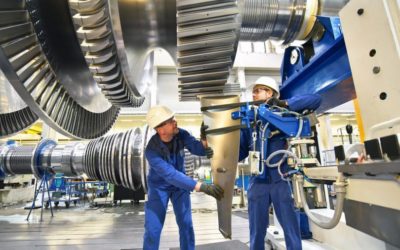Whether in private households or in the world of work, the networking of devices and objects with each other is increasingly finding its way into our everyday lives. Thus predicted Statista for the year 2020 over 30 billion networked objects, by 2025 even 75 billion.
One sector that particularly benefits from this development is the manufacturing industry - it is not for nothing that the term "Industry 4.0" has already become established for the digitalisation of production through the networking of people, machines and products. At the centre of Industry 4.0 is the smart factory as the production environment of the future.
In this article, we explain what is meant by the smart factory, what benefits can be realised through it and what role a data strategy plays in this context.
Inhaltsverzeichnis
What is the Smart Factory?
Why it is not yet possible to find a universally applicable explanation for the term smart factory is made clear, for example, by Wikipedia's definition:
Smart Factory is a term from research in the field of manufacturing technology. It is part of the German government's high-tech strategy as part of the future project Industry 4.0. It refers to the vision of a production environment in which manufacturing plants and logistics systems largely organise themselves without human intervention to produce the desired products.
Smart Factory therefore initially only describes the vision of creating an almost completely automated production environment. In reality, however, the degree of digitalisation of factories still varies greatly at the moment. For most companies, it is first about connecting machines and establishing connectivity, then about simpler questions (which machines are currently running?) and only later about individual automation tasks.
In the final stage of expansion, almost all machines are equipped with networking technologies of the Internet of Things connected and a cyber-physical system is created. For example, status, temperature, vibrations or fill levels are measured on machines and this information is continuously transmitted. This provides complete transparency about the processing status of the machines along the entire production chain, the so-called digital thread.
On this basis, optimal and automated decisions can then be made (when does a part need to be replaced? What next step is necessary?). In addition, customer satisfaction can be increased because the location and condition of each individual workpiece can be checked in real time and communicated to the customer.
Advantages of the Smart Factory: efficiency, reliability, quality improvement
The networked production environment offers a number of direct benefits. In the Smart Factory, the
- the efficiency of production
- the reliability of processes
- the quality of the products
At the same time, the number of production errors decreases. Through Predictive Maintenance and machine learning, problems can be detected at an early stage. In addition, the use of augmented reality means that plants no longer necessarily have to be serviced on site. This means that costly production interruptions can be avoided and plant maintenance can be made more efficient. In addition, the utilisation of the networked machines can be checked, thus facilitating resource planning. Finally, it is possible to produce complex objects or unique items with less effort.
The role of data in the Smart Factory
In order to benefit from all the advantages of a smart factory, a solid data basis is essential. The most common challenges are the lack of data availability, quality and consistency. In addition, many companies lack the necessary know-how. This includes a fundamental understanding of topics such as IIoT (Industrial IoT), AI (Artificial intelligence) and advanced analytics. In addition, the "big picture" - a holistic roadmap for the digitalisation of the production environment - is often missing.
Ideally, the data in the smart factory should be transparent and uniformly available, and the conditions for the intelligent use of the data should be created. This is supported by the right data strategy, which pursues the goal of consistently generating added value from data.
In order to make the Smart Factory project as a whole successful, one distinguishes between two approaches in a conceptual consideration:
- Top-down by defining a holistic data strategy that is embedded in the company's digitisation strategy
- Bottom-up by choosing an appropriate networking strategy
Smart Factories become a success when both strategies are pursued equally and the two approaches are intertwined.
In practice, the focus is currently often still on the bottom-up approach and the networking strategy: Which sensors / transmission technology do I use? Where do I store the data? Do I use the cloud?
The right data strategy for the Smart Factory
It is equally important to focus on the right data strategy at an early stage and thus also on the area in which bottom-up and top-down approaches are interlocked. In order to structure these challenges, five fields of action of a data strategy are distinguished:
- Use Cases
- Data Fundamentals
- Data governance
- Organisation, People & Skill
- Technology & Architecture
In the field of action of use cases, it is important to find the right process model for implementing efficiency and value creation measures. When working with data, the added value must be consistently in view.
The amount of data collected leads to challenges in data management, data quality and completeness. What is essential here is overarching Data governancewhich forms the organisational framework for data management. Who takes responsibility for the data? What standards must be followed? How are these implemented?
In addition, the right skills need to be established, companies need to expand their teams to include data scientists and engineers. Further training for other employees must also be considered.
In terms of technology and architecture, the following must be considered: For the use of Advanced Analytics and AI, the classic production systems such as ERP and MES must be networked across system boundaries. It must be clarified where the data for efficient processing is located and which tools are used. A key challenge here is also that IT and OT (operational technology) must merge - also called IT/OT convergence.
Smart Factory as a complement to human labour
It remains to be seen whether the smart factory will be characterised in the long term by production halls that are completely devoid of people. It is more likely that it will provide the basis for data-driven decisions and the increasing optimisation of production processes by humans through technologies such as AI.
However, due to ever shorter innovation cycles and, at the same time, more diversified markets, retooling of current production and adaptation to individual customer requirements will be unavoidable in the long run.
Conclusion
In the spirit of IT/OT convergence, data science and manufacturing are moving ever closer together. Dr. Andreas Schmidt, Managing Data Strategist at [at], and Peter Sorowka, CEO and Co-Founder at Cybus GmbH, explain in the webinar "Data Strategy and Networking in the Smart Factory" how these two areas can be successfully combined and responsibilities defined in order to generate real added value from data.












0 Kommentare